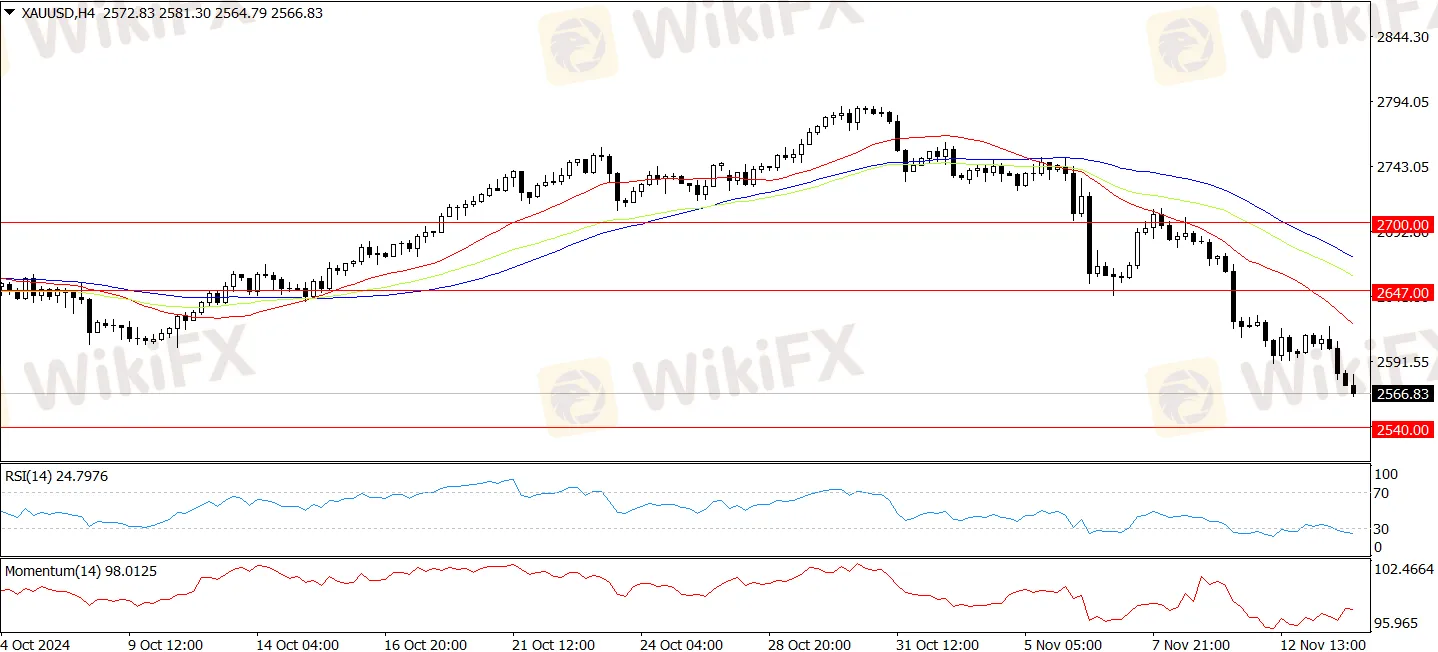简体中文
繁體中文
English
Pусский
日本語
ภาษาไทย
Tiếng Việt
Bahasa Indonesia
Español
हिन्दी
Filippiiniläinen
Français
Deutsch
Português
Türkçe
한국어
العربية
KVB Market Analysis | 14 Nov: US Dollar Strength Hits Gold: What's Next for XAU/USD
Sommario:Product: XAU/USD Prediction: Decrease Fundamental Analysis: Spot gold closed down $25.39 on Wednesday, a 0.98% drop, ending at $2,572.64 per ounce. Gold prices fell sharply as the US d
Product: XAU/USD
Prediction: Decrease
Fundamental Analysis:
Spot gold closed down $25.39 on Wednesday, a 0.98% drop, ending at $2,572.64 per ounce. Gold prices fell sharply as the US dollar strengthened following the release of the US CPI report. Upcoming economic events, including a speech from Federal Reserve Chair Jerome Powell and US retail sales data, are expected to further impact gold prices. On Wednesday, gold dropped significantly after the October US inflation report came in as expected. US Treasury yields rose, and the dollar reached its highest level this year, putting pressure on gold prices. Market participants are aware that if low taxes and new tariffs push inflation higher, President Trump's term could limit the Fed's easing policy. The US Department of Labor's report on Wednesday highlighted that since mid-year, progress in lowering inflation has slowed, which could lead the Fed to cut rates less frequently next year.
Technical Analysis:
After breaking below the October 10 low of $2,603 per ounce, gold has shifted from a neutral outlook to a bearish one. This opens the way for gold to test the 100-day Simple Moving Average (SMA) at $2,540 per ounce. If prices fall further, the next support level is at $2,500 per ounce. If gold recovers to $2,600 per ounce, buyers will focus on the 50-day moving average at $2,647 per ounce, followed by $2,650. Once these levels are broken, the next resistance is the November 7 high of $2,710 per ounce. With the Relative Strength Index (RSI) moving away from its neutral line, momentum has turned bearish, suggesting that gold prices may continue to fall.

Product: USD/JPY
Prediction: Increase
Fundamental Analysis:
USD/JPY pulled back after reaching a three-month high on Wednesday, as Japan‘s producer price data showed a bigger-than-expected rise in October. This higher producer inflation could lead to increases in consumer prices, which might prompt the Bank of Japan (BoJ) to raise interest rates, strengthening the Japanese Yen. Meanwhile, the US Dollar (USD) remains supported after October’s Consumer Price Index (CPI) report showed inflation ticking up, in line with expectations. This persistent inflation may discourage the Federal Reserve (Fed) from cutting rates, helping to keep the USD strong and likely limiting losses for the USD/JPY pair.
Technical Analysis:
On the H4 USD/JPY chart, the market is currently in a third wave of growth, aiming for the 156.15 level. After reaching this level, a correction toward 154.15 may start. Then, we expect a new wave of growth to the 157.00 level. The MACD indicator supports this scenario, with its signal line above zero and pointing upward. On the H1 USD/JPY chart, the market has formed a consolidation zone around 154.15 and is moving toward 156.15 in an upward trend. After hitting 156.15, we expect a correction back toward 154.15, with an initial target of 155.20. This scenario is supported by the Stochastic oscillator, with its signal line above 50 and pointing upward.

Product: EUR/USD
Prediction: Decrease
Fundamental Analysis:
On Wednesday, EUR/USD stayed under pressure for the fourth straight day, reaching new 2024 lows around 1.0550 as the US Dollar (USD) continued its strong rise, pushing the Dollar Index (DXY) close to its yearly peak near 106.50. The USD‘s strength was fueled by investor optimism about potential economic policies under the incoming Trump administration, called the "Trump trade." Meanwhile, EUR/USD’s decline was in line with rising US bond yields, while Germanys 10-year bund yields also rose, surpassing 2.40%. Last week, the Federal Reserve cut the interest rate by 25 basis points to 4.75%-5.00%, noting inflation is nearing the 2% target and that the labor market is softening slightly.
Technical Analysis:
Further losses could bring EUR/USD down to its 2024 low of 1.0555 (set on November 13), then to the November 2023 low of 1.0516 (from November 1), and finally to the 2023 low of 1.0448 (on October 3). On the upside, the 200-day Simple Moving Average (SMA) at 1.0866 acts as the first resistance, followed by the November high of 1.0936 (set on November 6) and the 55-day SMA at 1.0957. As long as EUR/USD stays below the 200-day SMA, more declines are likely. The four-hour chart shows a stronger downward trend, with initial support at 1.0555, then 1.0516. Immediate resistance levels are at 1.0726, followed by 1.0824. The RSI has dropped to about 25.

Disclaimer:
Le opinioni di questo articolo rappresentano solo le opinioni personali dell’autore e non costituiscono consulenza in materia di investimenti per questa piattaforma. La piattaforma non garantisce l’accuratezza, la completezza e la tempestività delle informazioni relative all’articolo, né è responsabile delle perdite causate dall’uso o dall’affidamento delle informazioni relative all’articolo.
WikiFX Trader
IC Markets Global
Vantage
HFM
Tickmill
Neex
FBS
IC Markets Global
Vantage
HFM
Tickmill
Neex
FBS
WikiFX Trader
IC Markets Global
Vantage
HFM
Tickmill
Neex
FBS
IC Markets Global
Vantage
HFM
Tickmill
Neex
FBS
Rate Calc


